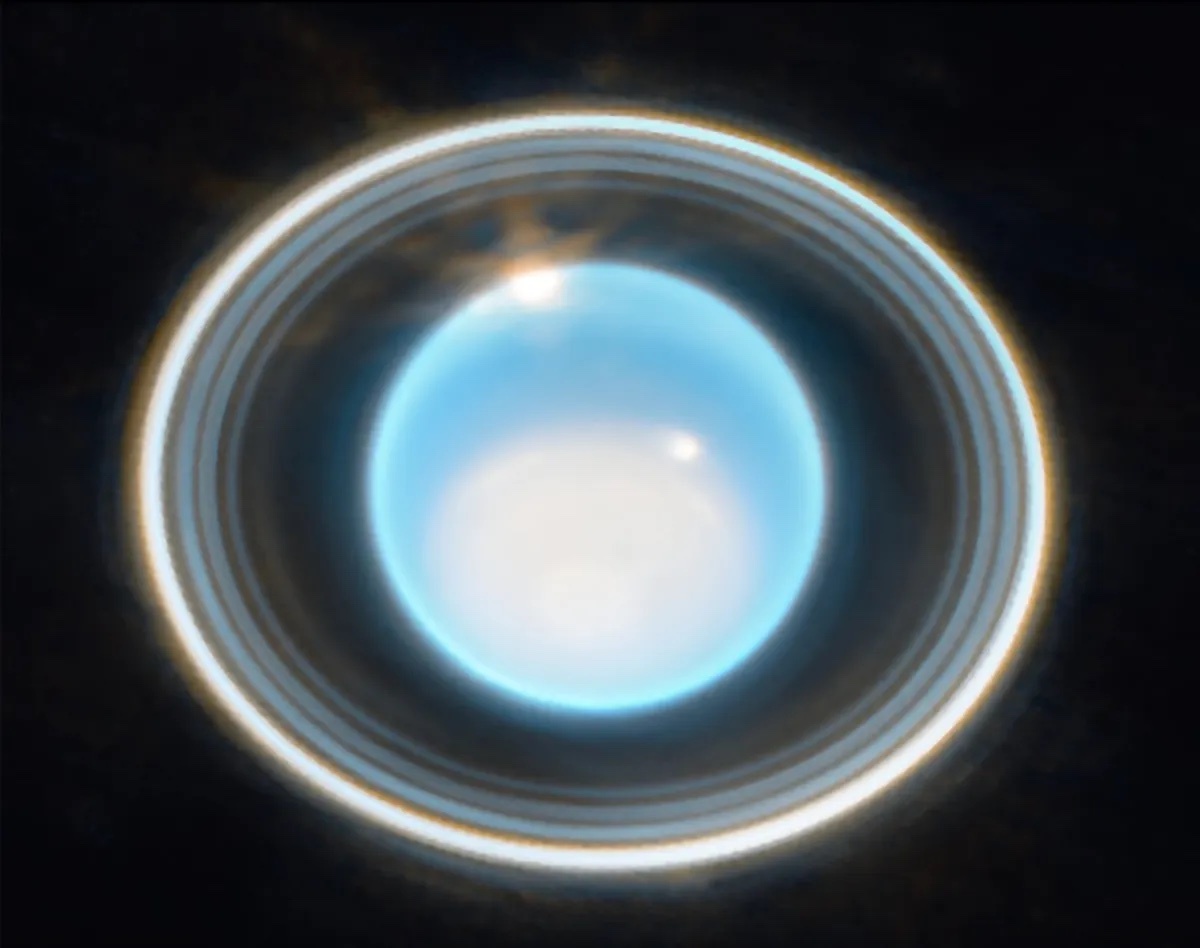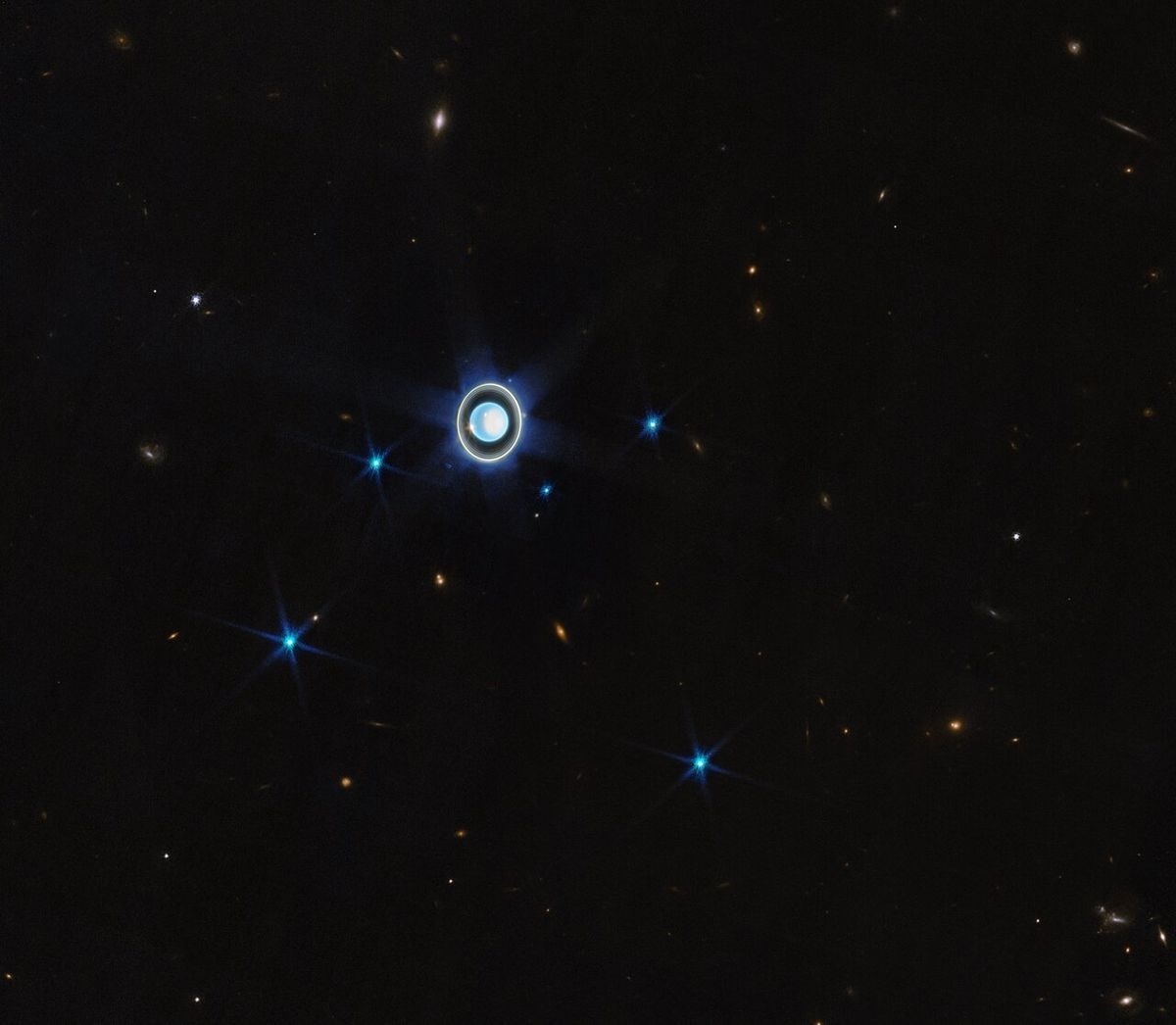31.10.2023
Computer simulations show how the largest of Uranus' 27 moons are able to keep the planet's stunted rings in check.

A zoomed-in image of Uranus as seen by the James Webb Space Telescope on Feb. 6, 2023. (Image credit: NASA, ESA, CSA, STScI, J. DePasquale (STScI))
The size of Uranus' rings is controlled by the planet's five major moons, which are able to eject significant amounts of dust out of the Uranian system, according to new simulations designed to figure out where the rings may have come from.
The seventh planet from the sun, Uranus is notable for being tilted on its side by 98 degrees, a legacy of a giant impact long ago in the planet's history.
"One of my motivations was to find out whether the rings of Uranus are artifacts from the original impact that knocked Uranus onto its side," said Stephen Kane, a professor of planetary astrophysics at the University of California, Riverside (UCR), in a telephone interview with Space.com. "The answer, it turns out, is probably not, because the ring material just wouldn't hang around for long."
Kane and fellow UCR planetary scientist Zhexing Li are authors of a new paper describing simulations of the interactions between Uranus' five main moons — Umbriel, Titania, Oberon, Miranda and Ariel — and the rings. In particular, the interactions are at their peak when the moons are in "mean motion resonances" with the rings.
A mean motion resonance between two orbiting objects occurs when the outer body's orbital period is a whole number greater than the orbital period of the inner body. For example, if a moon makes one orbit for every two orbits completed by ring particles at a certain distance from Uranus, they fall into gravitational resonance. This resonance can usher ring material out of the system and truncate the size of Uranus' ring system. It's the resonances with the two innermost of Uranus' large moons — the 298-mile-wide (480 kilometers) Miranda and the 720-mile-wide (1,160 km) Ariel — that have the greatest influence, severely truncating the rings at a distance of 4.3 planetary radii. (Uranus' radius is 15,759 miles, or 25,362km, so 4.3 planetary radii is 67,700 miles, or 109,000km).
Uranus' rings may have been larger and brighter when they originally formed, but have since been diminished by the scouring effect of the moons. The fact that Uranus still has rings suggests that they are being replenished by various sources of dust in the Uranian system. One primary source is impacts, large and small, on the moons.
"It's still relatively unknown what the impact rate is for Uranus," said Kane. "But [the existence of the rings in spite of this mass loss] does suggest that it might be higher than originally thought."
Besides impacts, outgassing could also contribute to the supply of particles in the system. When the icy moons enter resonances, gravitational tides from the other moons and Uranus itself can flex their interiors, instigating cryovolcanismthat leads to material being belched out from the moons.
Kane and Li found that, following an influx of dusty particles into the Uranian system from one of the above methods, the moons are able to expel 35% of that material within a distance of 40 planetary radii (a little over 630,000 miles, or about 1 million km) of Uranus in just half a million years. The rate of mass loss then slows and reaches 40% after tens of millions of years.
"I was surprised by how high that mass-loss rate is," said Kane. "It's the interaction between moons that causes this mass loss."

A full-sized wide shot of Uranus captured by the James Webb Space Telescope on Feb. 6, 2023 shows six of the planet's 27 known moons. (Image credit: NASA, ESA, CSA, STScI, J. DePasquale (STScI))
To make matters more complex, the orbits of Uranus' moons have changed over time.
"There's a lot of evidence that they have moved over time into different resonant locations," said Kane. Given that there are more opportunities for resonant orbits closer to Uranus, "the truncation of the rings would have been more severe in the past as those inner moons moved in and out of resonance."
The simulations also show that there were opportunities for the rings to have stable orbits between the orbits of the large moons.
"It's very interesting to think about what that would have looked like, with the moons embedded within the rings and the moons carving out these gaps," said Kane.
Uranus is not the only planetary system to act like this. In 2022, Kane performed a similar study of Jupiter, which has very faint and thin rings, belying the huge mass of the planet. In that study, Kane found that Jupiter's four large Galilean moons — Io, Europa, Ganymede and Callisto — were responsible for ejecting most of the dusty material that might otherwise find its way into the rings.
At the moment, the scenarios at Jupiter and Uranus only exist in theoretical modeling. Could a future mission to Uranus actually measure this mass loss from the system?
"It's more a question of whether there would be the opportunity to measure the mass loss at that time, because in order to observe mass loss, there needs to be mass present to be lost," said Kane. Without a geologically recent impact to replenish the dust supplies, "I would suspect that the amount of mass being lost at the present time is pretty minimal."
That idea could soon be put to the test. The recent planetary decadal surveyranked a Uranus orbiter mission as a top priority, with a launch in the mid-2030s at the latest, to arrive at Uranus in the 2040s. The mission will study Uranus' interior, measuring its gravitational field, which in turn will affect the mass-loss rate. If there is dust in the system, an orbiter may even detect it escaping. With Uranus still a relatively unexplored frontier in the solar system, with only one mission (NASA's Voyager 2) having briefly flown past it, there could be many exciting discoveries awaiting us in the future.
The research has not yet been published in a scientific journal. It's available on the arXiv preprint website.
Quelle: SC
